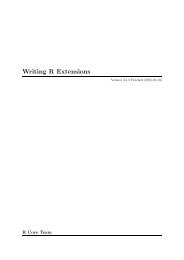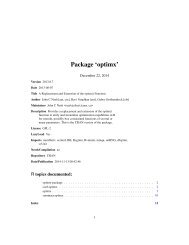Create successful ePaper yourself
Turn your PDF publications into a flip-book with our unique Google optimized e-Paper software.
24 na.locf<br />
Arguments<br />
Value<br />
object an object.<br />
na.rm logical. Should leading NAs be removed?<br />
fromLast logical. Causes observations to be carried backward rather than forward. Default<br />
is FALSE. With a value of TRUE this corresponds to NOCB (next observation<br />
carried backward). It is not supported if x or xout is specified.<br />
rev Use fromLast instead. This argument will be eliminated in the future in favor<br />
of fromLast.<br />
maxgap Runs of more than maxgap NAs are retained, other NAs are removed and the last<br />
occurrence in the resulting series prior to each time point in xout is used as that<br />
time point’s output value. (If xout is not specified this reduces to retaining runs<br />
of more than maxgap NAs while filling other NAs with the last occurrence of a<br />
non-NA.)<br />
rule See approx.<br />
... further arguments passed to methods.<br />
An object in which each NA in the input object is replaced by the most recent non-NA prior to it.<br />
If there are no earlier non-NAs then the NA is omitted (if na.rm = TRUE) or it is not replaced (if<br />
na.rm = FALSE).<br />
The arguments x and xout can be used in which case they have the same meaning as in approx.<br />
Note that if a multi-column zoo object has a column entirely composed of NA then with na.rm = TRUE,<br />
the default, the above implies that the resulting object will have zero rows. Use na.rm = FALSE to<br />
preserve the NA values instead.<br />
See Also<br />
zoo<br />
Examples<br />
az




